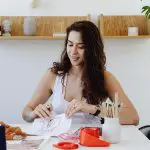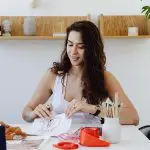Do you have a project that requires cutting a perfect circle in fabric? It may seem like a daunting task, but with the right tools and techniques, you can easily achieve a clean and precise cut.
In this article, we will guide you through the steps of cutting a circle in fabric, from gathering the necessary tools to finishing touches.
Before you begin, make sure you have all the tools you need. You will need a fabric marker, a pair of sharp fabric scissors, and either a compass or a round object to use as a template.
Once you have your tools, you can choose your cutting method. There are several ways to cut a circle in fabric, including using a compass and scissors, using a rotary cutter and mat, or using a template and scissors.
Each method has its own advantages and disadvantages, so choose the one that works best for you.
Table of Contents
Gather the Necessary Tools
You’ll need a pair of sharp scissors, a fabric marker, and a round object like a plate or bowl to trace around. These tools are essential to cut a perfect circle in fabric. Make sure your scissors are sharp enough to cut through the fabric without fraying the edges. The fabric marker should be easy to see on the fabric and not too thick or thin.
Once you’ve gathered all the necessary tools, you can start cutting your circle. Place the round object on the fabric and trace around it with the fabric marker. Make sure the object is centered on the fabric and that the circle is the size you want it to be. You can use a ruler to measure the diameter of the circle if you want it to be precise.
After tracing the circle, use the scissors to cut along the line. Take your time and cut slowly to avoid cutting too much or too little of the fabric. It’s better to cut a bit at a time and adjust as needed than to cut too much and ruin the fabric.
With these tools and steps, you’ll be able to cut a perfect circle in fabric every time.
Choose Your Cutting Method
When selecting your preferred cutting technique, it’s important to consider your level of comfort and experience with the tools at hand. There are a few different methods to choose from, each with its own advantages and disadvantages. Here are three options to consider:
-
Scissors: This is the most straightforward method, but it requires a steady hand and a sharp pair of scissors. Simply trace your circle onto the fabric and carefully cut along the line. If you’re working with a slippery or stretchy fabric, it may be easier to use fabric weights or pins to keep the fabric in place while you cut.
-
Rotary cutter: If you’re comfortable using a rotary cutter, it can be a quick and precise way to cut circles. Use a compass or other round object to trace your circle onto the fabric, then use the rotary cutter to cut along the line. This method is especially useful for cutting multiple circles at once.
-
Die cutting machine: If you have access to a die cutting machine, this can be a great option for cutting circles quickly and accurately. Simply choose the right size circle die and run it through the machine with your fabric. This method is ideal for cutting large quantities of circles or for ensuring a perfect circle every time.
No matter which method you choose, make sure to take your time and work carefully to avoid mistakes. With a little practice, you’ll be cutting circles like a pro in no time!
Prepare Your Fabric
Get ready to create a stunning masterpiece by preparing your material with care and attention. Before cutting your fabric, make sure it’s clean and free from any wrinkles or creases. Iron it if necessary, but be careful not to stretch or distort the fabric.
Next, decide on the size of the circle you want to cut. Measure and mark the center point of the circle on your fabric using a fabric marker or chalk. To make sure the circle is symmetrical, use a compass or a round object as a guide to draw a perfect circle.
Secure your fabric on a cutting mat using pins or weights to prevent it from moving while cutting. Choose the cutting method that works best for you and carefully cut along the marked circle. Remember to use sharp scissors or a rotary cutter to ensure a clean and precise cut.
With these simple steps, you’re now ready to cut a perfect circle in your fabric and start creating your masterpiece.
Mark Your Circle
Now that you’ve got your fabric ready, it’s time to mark your circle. There are a few methods you can use to do this. You can use a template, a compass, or measure and mark by hand.
Using a template is a simple and accurate way to create a perfect circle. A compass allows you to adjust the size of the circle as needed. Measuring and marking by hand can be a bit trickier, but it’s a good option if you don’t have access to a template or compass.
Remember to group complete sentences on their own lines, with a double new line after.
Using a Template
To achieve precise circles in your fabric, you can utilize a template that will guide your cutting process. Making a template is easy and can be done using materials that are readily available in your home. Here’s how:
- Gather all the materials you’ll need: cardboard or plastic sheet, compass, ruler, pencil, and scissors.
- Draw a circle on the cardboard or plastic sheet using the compass. Make sure the circle has a diameter equal to the size of the circle you want to cut out on your fabric.
- Cut out the circle using the scissors.
Place the template on top of your fabric and trace it using a pencil. Cut out the circle following the traced line.
Using a template is a great way to ensure your circles are precise and uniform in size. With this technique, you can easily create circles of different sizes without worrying about making mistakes or uneven edges. So, go ahead and try this method for your next sewing project and see how it can help you achieve perfect circles every time.
Using a Compass
Creating precise circles in your sewing project can be a breeze with the help of a compass, allowing you to easily achieve the perfect shape every time.
To start, select a compass that’s suitable for the size of circle you need to cut. Adjust it to the desired size by loosening the screw and sliding the legs to the appropriate position, then tightening the screw again to secure it in place.
Next, place the point of the compass at the center of the circle you need to cut. Hold the pivot point firmly with your non-dominant hand and use your dominant hand to rotate the compass, keeping the lead point in contact with the fabric as you go.
Move the compass around the center point in a complete circle, using a slight amount of pressure to make sure the fabric is cut cleanly. Once you’ve gone all the way around, simply lift the fabric and your perfectly round circle will be ready to use!
Measuring and Marking
When measuring and marking your fabric, it’s important to use straight lines and precise measurements to ensure accuracy in your project. One way to do this is by using a ruler or tape measure to mark the circumference of your circle. First, determine the diameter of your circle by measuring from one side to the other. Then, divide that measurement by two to get the radius. Use the radius to measure out the circumference of your circle along the edge of your fabric, making small marks at regular intervals.
Once you have marked out the circumference of your circle, you can connect the marks to create a smooth curve. One way to do this is by using a French curve ruler, which has a variety of curved edges that can be used to create different shapes. Alternatively, you can use a piece of string or ribbon to connect the marks, pulling it taut to create a straight line between each point. With these methods, you can easily and accurately cut a circle in your fabric for your next sewing project.
| Pros | Cons | Tips | ||
|---|---|---|---|---|
| Allows for precision | Time consuming | Use a sharp pencil or fabric marker | ||
| Can be done with basic tools | Requires math skills | Double-check measurements before cutting | ||
| Works for any size circle | More difficult with thicker fabrics | Consider using a rotary cutter for smooth edges | Practice on scrap fabric before attempting on final project |
Cut Your Circle
Now you can easily cut your circle by simply folding the fabric in half twice and using a pair of sharp scissors to carefully cut along the edge. Make sure that the fabric is properly aligned before cutting to avoid uneven edges. You can use pins or weights to keep the fabric in place while cutting.
Another technique is to use a rotary cutter and a cutting mat. Place the fabric on the mat and use a compass to draw the circle on the fabric. Make sure that the compass is sharp and the fabric is held in place. Use the rotary cutter to carefully cut along the line, keeping the blade vertical and steady.
After cutting the circle, remove any pins or weights and unfold the fabric. You should have a perfect circle that can be used for various sewing projects. Remember to always use sharp scissors or a rotary cutter for a clean and precise cut.
With these simple steps, you can easily cut a circle in fabric without any hassle.
Finishing Touches
Now that you’ve successfully cut your circle, it’s time to finish it off with some key details.
First, you’ll want to trim the edges to ensure they’re neat and even.
Next, take time to press the fabric to create crisp folds and avoid any wrinkles.
Finally, before beginning to sew, make sure to add seam allowance to your circle to ensure a clean, finished look.
These simple finishing touches will take your project to the next level.
Trimming Edges
To neaten up the edges of your circle, simply trim them with a pair of sharp fabric scissors. Make sure to cut slowly and carefully, following the curve of the circle to ensure a smooth, even edge.
If you accidentally cut too much, don’t worry! You can always trim a little more, but you can’t undo a cut that’s too short.
Once you’ve trimmed the edges, take a moment to admire your handiwork! Your circle should now have clean, finished edges that are ready for whatever project you have in mind.
Whether you’re making a quilt, a tablecloth, or a piece of clothing, a neatly cut circle is sure to add a professional touch to your finished product.
Pressing
You’ll want to grab your iron and give your newly trimmed circle a good pressing, smoothing out any wrinkles or creases that may have formed during the cutting process.
This step is important not only for ensuring a smooth and even final product, but also for making it easier to work with the fabric as you move forward in your project.
To press your circle, simply lay it flat on your ironing board and gently run the iron over the surface, taking care not to stretch or distort the fabric. If there are particularly stubborn wrinkles, you can use a bit of steam to help smooth them out.
Once you’re finished pressing, your circle should be ready to go for whatever project you have in mind!
Adding Seam Allowance
Before taking your fabric to the sewing machine, make sure to add seam allowance to the edges of your freshly pressed circle, ensuring that your final product will have the necessary room for stitching and finishing. Seam allowance is the extra fabric that you leave around the edges of your circle to allow for the seams to be sewn. Without it, your circle will be too small and tight, making it difficult to stitch and finish.
To add seam allowance, you can use a ruler and fabric marker to measure and mark the desired amount around the circumference of your circle. A good measurement to use is 1/4 inch or 1/2 inch, depending on the project. Once you have marked the seam allowance, use fabric scissors to carefully cut around the circle, making sure to leave the marked seam allowance intact. With seam allowance added, your circle is now ready to be stitched and finished into a beautiful final product.
| Column 1 | Column 2 | Column 3 | Column 4 | Column 5 | |
|---|---|---|---|---|---|
| Step 1 | Press your fabric to remove any wrinkles or folds. | Step 2 | Use a ruler and fabric marker to measure and mark the desired seam allowance around the circumference of your circle. | Step 3 | |
| Step 4 | Use fabric scissors to carefully cut around the circle, making sure to leave the marked seam allowance intact. | Step 5 | Your circle is now ready to be stitched and finished into a beautiful final product. |
Tips for a Clean and Precise Cut
When cutting fabric, it’s important to keep it taut to avoid any distortion or unevenness. Make sure to use sharp scissors to ensure a clean and precise cut. It’s also helpful to make small cuts and take your time to prevent any mistakes.
Remember, taking your time and using the right techniques will result in a more professional-looking finished product.
Keeping the Fabric Taut
To ensure your fabric stays taut while cutting a circle, it’s important to hold it firmly in place with one hand while cutting with the other. This will prevent any wrinkles or folds from forming, which can lead to inaccurate cuts.
You can use a few different methods to do this, depending on your personal preferences and the size of the circle you’re cutting. One option is to use a large embroidery hoop to stretch the fabric tight. Simply place the fabric over the hoop and tighten the screw to hold it in place. This will keep the fabric taut and prevent it from moving around while you cut.
Another option is to tape the fabric to a table or cutting mat using painter’s tape or masking tape. Make sure the tape is secure and the fabric is pulled tight before you begin cutting. With these techniques, you can ensure a clean and precise cut every time.
Using Sharp Scissors
Sharp scissors are essential for achieving clean and precise edges on your material when working on a project. Dull scissors can cause fraying and uneven cuts, which can ruin the final outcome of your project.
Here are some tips for using sharp scissors to cut a circle in fabric:
-
Invest in a good pair of fabric scissors: Using the right type of scissors for your project can make a big difference in the quality of your cuts. Fabric scissors are designed to cut through fabric smoothly without causing fraying or jagged edges. Make sure to keep them sharp by using a sharpening stone or taking them to a professional for sharpening.
-
Use a cutting mat: A cutting mat can protect your work surface and keep your fabric in place while you cut. It also provides a grid to help you measure and cut your fabric accurately.
-
Cut slowly and carefully: Take your time when cutting around the circle, following the line you have drawn. Make small cuts and adjust as necessary to ensure you are cutting in the right direction.
-
Practice makes perfect: Cutting circles in fabric can be tricky, so don’t be discouraged if your first attempt doesn’t turn out perfectly. Keep practicing and experimenting with different techniques until you find what works best for you.
Making Small Cuts
As you work on your project, it’s important to remember the significance of making precise and delicate incisions. When cutting a circle in fabric, it’s important to make small cuts instead of one big cut. This is because small cuts allow you to have more control over the fabric and prevent any mistakes.
To make small cuts, hold your scissors at a slight angle and make small snips around the edge of the circle. Make sure to only cut a small amount at a time, and rotate the fabric as you go to make sure you’re cutting evenly.
If you do accidentally make a larger cut than intended, don’t panic. You can always use a needle and thread to sew the fabric back together and make it look seamless.
By taking your time and making small cuts, you’ll be able to create a perfectly round circle in your fabric.
Taking Your Time
Now that you’ve learned how to make small cuts, it’s time to focus on taking your time when cutting a circle in fabric. This is a crucial step in ensuring that your circle is neat and accurate, which is especially important if you’re using it for a pattern or design.
Firstly, make sure you have a sharp pair of scissors before starting. Next, take a deep breath and try to relax your hands and arms. This will help prevent any shaking or jerking movements that can cause uneven cuts. When ready, start cutting slowly and steadily around the circle. Don’t rush or try to cut through the fabric in one go, as this can cause jagged edges. Instead, make small cuts and gradually work your way around the circle.
To make this process even smoother, consider the following tips:
- Hold the fabric taut as you cut to prevent any bunching or wrinkling.
- If you need to make any adjustments, stop cutting and reposition the fabric before continuing.
- Take breaks if you need to, as tired hands and eyes can make it harder to cut accurately.
Remember, practice makes perfect, so don’t be discouraged if your first circle doesn’t turn out perfectly. Keep practicing and soon you’ll be cutting circles with ease!
- The Official Robert Kaufman Kona Cotton Color Chart Explained - June 20, 2025
- What Is Kona Cotton Fabric? A Complete Guide for Quilters - June 20, 2025
- The Unique Appeal of China Seas’ Outdoor Fabric Line - June 20, 2025





